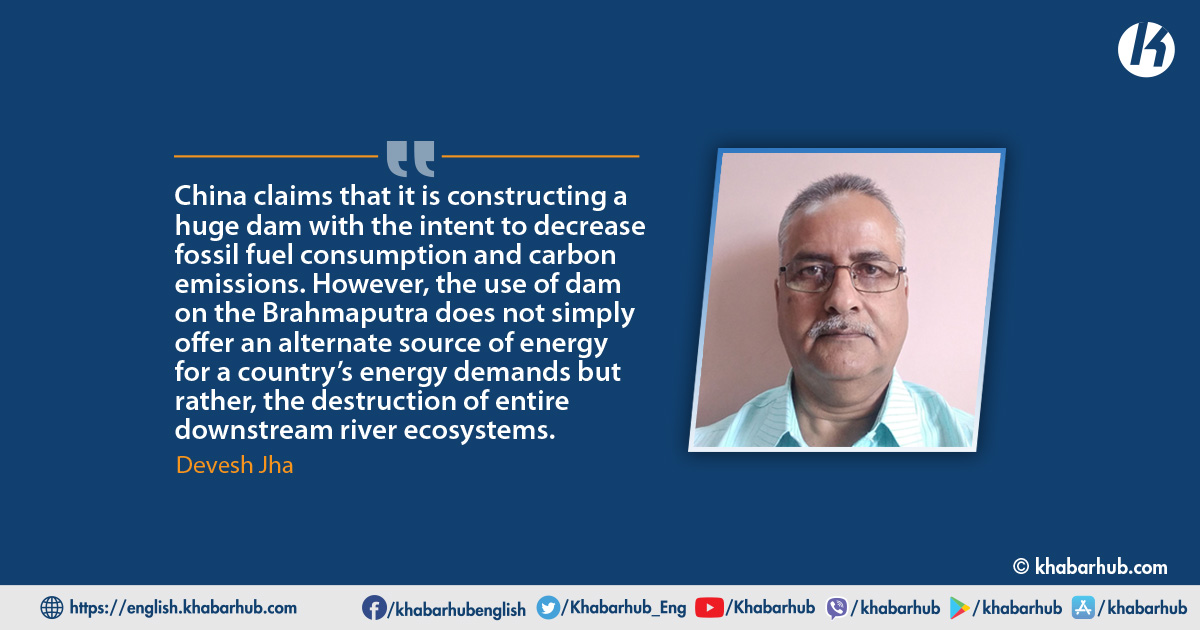A draft of China’s new Five-Year Plan 2021-25 has given a green signal paving the way towards constructing a large dam on the lower reaches of the Yarlung Tsangpo (Zangbo) river.
The draft outlines the plan (FYP) for 2025 and “long-range objectives through the year 2035”, submitted before the National People’s Congress (NPC) — China’s ceremonial legislature — specifically approved the building of hydropower bases on the lower reaches of the river as priority basis in next five years.
Yarlung is the name for the Brahmaputra in Tibet with its origin in the Manasarovar Lake region, near Mount Kailash, located on the northern side of the Himalayas in Burang County of Tibet as the Yarlung Tsangpo.
It flows through southern Tibet, Siyang in Arunachal Pradesh, the Brahmaputra for Assam Valley, and through Bangladesh as Jamuna merges with Padma (the popular name of river Ganges) in Bangladesh. Finally merging with Padma, the river is christened Meghna before emptying into the Bay of Bengal.
Brahmaputra’s upper course was long unknown, and its identity with the Yarlung Tsangpo was only established by exploration in 1884–86.
The lower reaches are sacred to Hindus. While most rivers on the Indian subcontinent have female names, this river has a rare male name. The Brahmaputra means “son of Brahma” in Sanskrit.
As the Chinese were not serious with the issue, and after long pursuing, they finally made a deal with India. Even though there is no water cooperation treaty between India and China, the countries signed a Memorandum of Understanding (MoU) in 2002 for the sharing of hydrological data.
The Brahmaputra is a perennial river, with several peculiar characteristics due to its geography and prevailing climatic conditions.
Inhabitants along the river have to deal with two floods annually. One is caused by the melting of the Himalayan snow in summer and the other due to the monsoon flows.
As the river is prone to catastrophic flooding average discharge of the river is about 19,800 m3/s while floods reach about 100,000 m3/s.
The frequency of these floods has increased and is devastating due to climate change and its impact on high and low flows posing a grave concern for the population and food security in the lower riparian states.
The river is in itself dynamic as frequent landslides and geological activity force it to change its course very often. About 3,848 km long, the Brahmaputra is an important river for irrigation and transportation in the region.
China has always been a water-scarce country with uneven distribution of its water resources. It constitutes almost 20% of the global population but has just 7% of the water resources. That’s why they have an ambitious plan to link their south and north through canals, aqueducts, and the linking of major rivers to ensure water security.
There are now multiple operational dams in the Yarlung Tsangpo basin with more dams commissioned and under construction.
These constructions present a unique challenge for environmental impact. They will eventually lead to degradation of the entire basin as massive amounts of fertile soil carried by the river would get blocked by dams leading to a fall in the quality of land and eventually reducing agricultural productivity.
In the same way, the Brahmaputra basin is one of the world’s most ecologically sensitive zones. It is identified as one of the world’s thirty-four biological hotspots. This region sees several species of flora and fauna that are endemic to only this part of the world.
The Kaziranga National Park is the homeland for thirty-five mammalian species out of which fifteen are listed as threatened in the IUCN conservation list.
The river itself is home to the Gangetic river dolphin, which is listed as critically endangered. In the same way, the location of the dam will pose risk to bring disasters as this is more dangerous zone for earthquakes.
Seismologists consider the Himalayas as most vulnerable to earthquakes and seismic activities. Landslides resulting from earthquakes pose a significant threat.
The 2015 Nepal earthquake which was more than 8.2 on the Richter scale resulting landslides wiped out several dams and other facilities.
Recently Nepal is witnessing big damages to life and properties due to flooding caused by cracks in mountain regions because of huge shock waves that occurred in the earthquake.
The sheer size of the infrastructure projects undertaken by China poses a significant threat to the populations living downstream. Close to a million people live in the Brahmaputra basin in India and tens of millions further downstream in Bangladesh.
In 2010, water experts from China, India, Bangladesh, and Nepal met to discuss the importance of shared information, collaboration, and open dialogue between the member states involving in the Himalayan River Basin.
This agreement between member states reiterates the understanding that each member state has for the importance of shared data, the consequences of climate change, and the need to defend the equal interest of downstream nations.
This declaration was an effort to go beyond the involvement of China and India but include all riparian nations who have a stake in the outcome of changes on the Brahmaputra River.
There is a reduction of biodiversity due to the blocking of movement for various organisms. All these changes will cause the decline of fishery and finally to the damage of livelihoods for the people depending on the Brahmaputra.
As the Chinese were not serious with the issue, and after long pursuing, they finally made a deal with India. Even though there is no water cooperation treaty between India and China, the countries signed a Memorandum of Understanding (MoU) in 2002 for the sharing of hydrological data.
Under the MoU, China agreed to share information about the discharge of water at three stations between June 1 to October 15 each year.
This was later revised to twice a day between the same period. The data is considered crucial for flood control and planning during the monsoon period in India.
However, when relations between the two nations soured during the months-long Doklam standoff in 2017, China refused to share information. The move gave rise to fears that it may use its upstream position for strategic leverage.
The data sharing resumed in 2018, but strategically it was noticed that China will not hesitate to use water as a political weapon if required.
China has already blocked the flow of the Xiabuqu river, one of Brahmaputra’s Tibetan tributaries, for the Lalho hydel project in 2017.
The Siang river, which joins the Lohit and Dibang downstream to form the Brahmaputra, turned muddy and “blackened”.
In past China, being an upper riparian has blocked river Mekong and its tributaries too. That severely affected Thailand, Vietnam, Laos and Cambodia.
It has caused immense damage to the environment, drought, and altered river flow in the region. China sees these projects as a continuation of its historic tributary system. Now in the Himalayas, they have recently begun to operate.
The main environmental impact of a dam will be that it changes the flow of the river from an upstream river valley to a reservoir.
With so much water hanging overhead is obviously a big threat to lower riparian states, India and Bangladesh. Even they have raised concerns over China’s plan to build the massive dam on the Brahmaputra River. But China has downplayed such anxieties saying it would keep their interests in mind.
Additionally, there are downstream changes of the riverbed, banks, delta, and coastline due to altered sediment load.
There are changes in the downstream water quality including river temperature, nutrient load, dissolved gases and minerals.
There is a reduction of biodiversity due to the blocking of movement for various organisms. All these changes will cause the decline of fishery and finally to the damage of livelihoods for the people depending on the Brahmaputra.
Fisheries provide an important livelihood function among rural populations in today’s world and so for Indian and Bangladeshi fishery production.
The construction of a big dam by China will ultimately block fish migration and thus it will create a huge impact on migratory marine fishes like Dolphin of the Gangetic range which is already enlisted for endangered species.
Melting glaciers and barrier lakes could also pose a big threat to the world’s biggest hydroelectric dam as it is proposed where the Brahmaputra Grand Canyon is located.
Even their own engineers are concerned about the threats posed by landslides and barrier lakes to the dam as it could put a halt to the plan.
In 2018, a landslide caused by a melting glacier blocked the Yarlung Tsangpo, the upper stream of the Brahmaputra River, at the Sedongpu Basin in Milin county, reports said. It formed a lake containing about 600 million cubic meters of water.
With the river spilling over the top at present, the dam could collapse at any time, claimed in the report. The Sedongpu lake sits just a few dozen kilometers upstream from the planned construction site of the super hydropower plant.
The collapse of the ecosystem will lead to the displacement of indigenous human populations that represent the beginning of humanity and life that relied on rivers since their ancestors.
With so much water hanging overhead is obviously a big threat to lower riparian states, India and Bangladesh. Even they have raised concerns over China’s plan to build the massive dam on the Brahmaputra River. But China has downplayed such anxieties saying it would keep their interests in mind.
China claimed that they are constructing this huge dam with the intent to decrease fossil fuel consumption and carbon emissions.
However, the use of a dam on Brahmputra does not simply offer an alternate source of energy for a country’s energy demands but rather, the destruction of entire downstream river ecosystems.
This destruction includes the erosion of river embankments and beds due to the unexpected flow of water. The collapse of the ecosystem will lead to the displacement of indigenous human populations that represent the beginning of humanity and life that relied on rivers since their ancestors.
In summary, this proposed dam may bring disasters, as the construction site is in a seismic active zone, huge loss of fishery, mammalian, livelihoods and even big threat to endangered species.
It will create a negative impact on the ecosystem due to the unnatural flow of water which will eventually damage embankments, river beds and finally greenery. Obviously, this will be a big disaster to the ecosystem and China has no right to that.









Comment